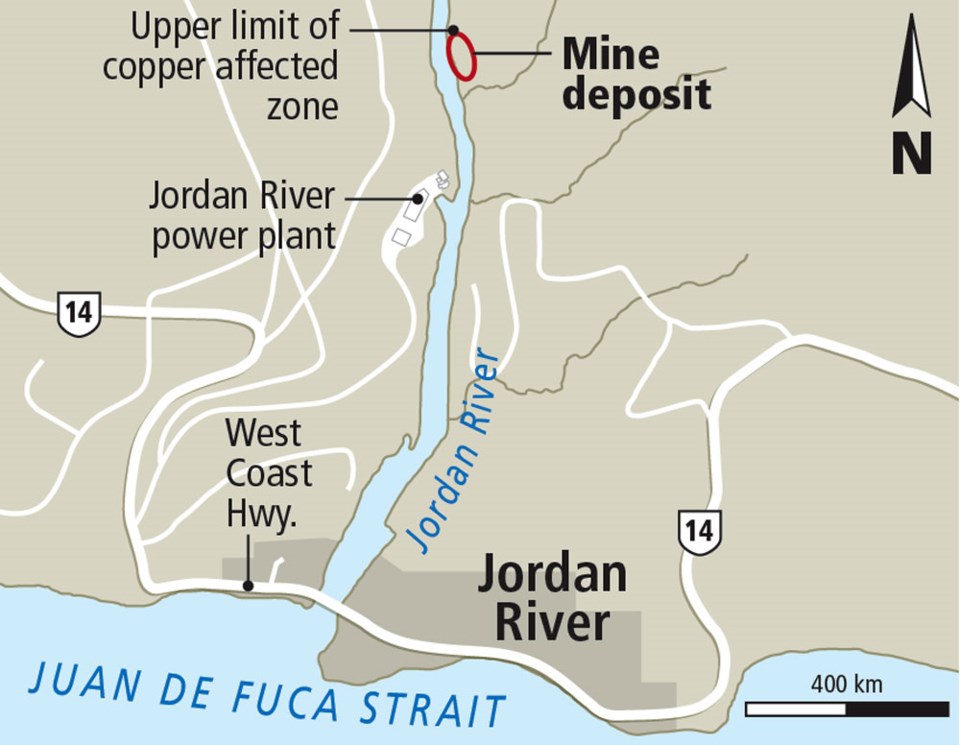B.C. Minister of Energy and Mines Bill Bennett says he doesn’t know why a high-risk mine site leaching copper into the Jordan River was deemed clean by the province in 1993.
The now-defunct Sunro Mine and surrounding area has been identified as the source of copper contamination in the river, which once supported thousands of salmon. The fish numbers are much lower today, and the river banks don’t have much vegetation.
The problem came to the province’s attention through the work of concerned citizen Ken Farquharson, who spearheaded efforts to identify a responsible party, to complement other efforts to bring salmon back.
“I don’t know why. I had no way of knowing, my staff are researching and trying to figure that out. But whatever the research turns up, there’s no excuse for it,” Bennett said.
“I don’t think the government should be trying to excuse the mistake, which is obviously what it was. And we’re certainly appreciative of the fact that a citizen took it upon himself to dig into this and bring it to the government’s attention.”
Evidence today shows contamination, but a mine inspector under Mike Harcourt’s NDP government issued a letter in 1993 stating, “final reclamation carried out and found satisfactory,” a report by SNC-Lavalin, commissioned by former site owner Teck Resources Ltd., found.
After a site is deemed clean, no further inspections are typically conducted, Bennett said.
Cominco, now owned by Teck, acquired mining rights to the area in 1919 and leased them to other companies over the years. Mining occurred on and off, with about 600,000 tonnes of ore mined between 1949 and 1950 and about 1.3 million tonnes mined or milled between 1962 and 1974. The land was returned to the Crown in 1993, after cleanup was deemed satisfactory, and now belongs to Western Forest Products.
Teck, identified by the University of Victoria’s Environmental Law Centre as the responsible party, has completed a risk assessment and its results were confirmed by the Ministry of Environment as “high risk.” The ministry has asked Teck and Western Forest Products to submit a cleanup plan and schedule by June 2017. “Now that we’re aware of it, we’ll make sure that whatever remediation is required gets done,” Bennett said.
The province has not determined who will be responsible for paying cleanup costs, but pointed to its “polluter pays” principle.
At least one other closed mine has been identified where the province might have to step in and require a company to pay for cleanup, he said.
The province manages a list of contaminated sites, which includes closed mines. Those sites are cleaned in order of environmental risk, Bennett said.
He said the government is taking seriously recommendations made by the auditor general’s office, in addition to more than 40 other recommendations from combined reports that followed the Mount Polley disaster, in which a tailings pond failed and its contents spilled into nearby lakes.
The auditor general said taxpayers need to be safeguarded by ensuring reclamation liability estimates are accurate and security held by the government is sufficient to cover potential costs. The report found major mines are under-secured by more than $1.2 billion.
“I think the constructive criticism from the auditor general that B.C. doesn’t have sufficient bonding amounts in place in all cases is fair and constructive,” Bennett said. “We’re identifying mines in that category and we’re in the process of increasing the size of the bonds in place.”



